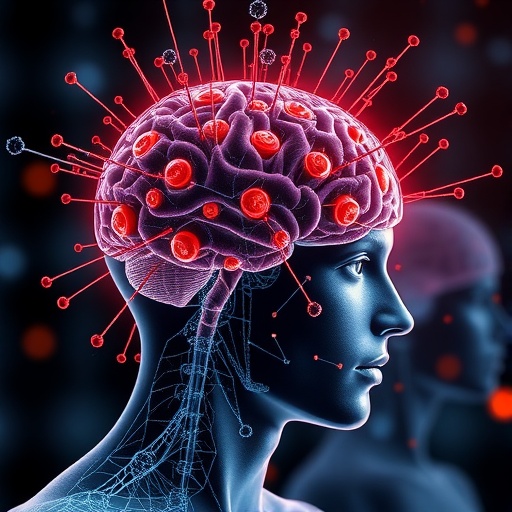In the intricate workings of the brain, the circadian rhythm governs countless physiological processes, orchestrated by a complex interplay of molecular components. Among these, the transcription factor CLOCK has long been recognized as a crucial regulator, ubiquitously expressed across tissues to maintain robust circadian cycles. Yet, recent groundbreaking research reveals a layer of complexity previously unappreciated: human-specific expression of CLOCK within the neocortex, pointing toward an evolutionary adaptation with profound implications for brain function.
A team of neuroscientists led by Liu, Y., Fontenot, M.R., and Kulkarni, A., has pioneered a mouse model that emulates the unique cortical expression patterns of human CLOCK. Their innovative “HU” mouse model demonstrates altered spatiotemporal expression of CLOCK in the neocortex, a feature absent in wild-type mice. This shift in expression correlates with significant cognitive enhancements, notably in measures of flexibility and adaptability—key elements underpinning complex thought and learning.
Delving deeper, the researchers employed cell-type-specific genomic profiling, a technical tour de force allowing unparalleled insights into gene expression within excitatory neurons of the neocortex. This meticulous approach uncovered an upregulation of genes tied to dendritic growth and spine formation—structural components essential for synaptic connectivity and plasticity. These findings suggest that CLOCK’s human-specific expression may facilitate increased neural complexity, thereby enhancing information processing capacity at the synaptic level.
Morphological analyses provided compelling confirmation. Excitatory neurons within the HU mice exhibited marked increases in dendritic branching and spine density when compared to control counterparts. Such structural elaborations are directly linked to augmented excitatory postsynaptic currents, indicating heightened neural connectivity and synaptic transmission efficiency. These physiological modifications paint a vivid picture of how molecular adaptation translates into tangible neural circuitry enhancements.
Simultaneously, the research extended into human cellular models using induced pluripotent stem cell (iPSC)-derived neurons. When CLOCK was knocked out in these human neurons, the researchers observed a contrasting phenotype characterized by diminished dendritic complexity and reduced presynaptic puncta density, underscoring the importance of CLOCK in maintaining structural and functional neuronal integrity. This complimentary set of findings strengthens the argument that CLOCK exerts a vital influence on cortical development and synaptic architecture.
The implications of these discoveries resonate profoundly with our understanding of human brain evolution and cognitive specialization. CLOCK’s altered spatiotemporal expression in the neocortex likely represents an evolutionary gain-of-function, allowing the human brain to support enhanced neural connectivity and higher-order cognitive processes. This posits CLOCK not merely as a circadian regulator but as a molecular catalyst in shaping human neural complexity.
Beyond the fundamental neuroscience, the potential translational impact of these findings is vast. Cognitive flexibility deficits are hallmark features of numerous neuropsychiatric disorders including autism spectrum disorder and schizophrenia. Understanding the molecular drivers—such as human-specific CLOCK expression—that enhance cognitive flexibility could open novel therapeutic avenues that target gene expression pathways to ameliorate cognitive dysfunction.
Intriguingly, this research bridges molecular chronobiology with neurodevelopment, two fields historically regarded as distinct. By revealing CLOCK’s dualistic role in circadian rhythms and cortical maturation, the study invites a reevaluation of temporal regulation in brain function and its evolutionary pressures. It suggests that evolutionary rewiring of gene expression timing can fuel expansions in cognitive aptitude.
The genetic engineering techniques employed to generate the HU mouse model underscore cutting-edge methodologies in modern neuroscience. By precisely editing regulatory elements to mimic human gene expression, the scientists established a powerful platform to investigate human-specific brain traits in vivo. This technological advance heralds a new era where interspecies comparisons extend beyond DNA sequences to functional gene regulation landscapes.
Moreover, the utilization of electrophysiological recordings provided critical evidence linking molecular and structural changes to functional output. Observed increases in excitatory postsynaptic current frequency in HU mice translate the profound morphological alterations into enhanced synaptic communication, reinforcing the concept that CLOCK shapes neural network dynamics.
This multipronged approach combining genomics, neuroanatomy, electrophysiology, and iPSC-derived neuronal models provides a comprehensive narrative of how one transcription factor can leverage evolutionary advantage. It exemplifies integrative research vital for decoding the complexity of human brain evolution, potentially inspiring further studies of other genes with modified spatial-temporal expression profiles unique to humans.
Importantly, the study’s findings emphasize that gene regulatory changes can underpin significant phenotypic innovation beyond protein-coding mutations. Altered timing and localization of CLOCK expression may orchestrate cascades of downstream gene activations facilitating dendritic elaboration, synaptic proliferation, and ultimately, cognitive sophistication.
This research not only enriches the fundamental framework of molecular neurobiology but also has the potential to ignite cross-disciplinary conversations spanning evolution, cognitive neuroscience, and psychiatry. It challenges the scientific community to rethink the functional multiplicity of classic circadian molecules within human-specific contexts.
In summary, the human-specific expression pattern of the CLOCK transcription factor within the neocortex appears to be a pivotal evolutionary adaptation that enhances neural architecture and cognitive flexibility. By recapitulating this pattern in a novel mouse model, the study delivers compelling evidence that CLOCK’s spatiotemporal gene regulation is a potent driver of human brain specializations, opening promising pathways for future exploration and clinical innovation.
Subject of Research: Evolutionary neurobiology and gene expression regulation in neocortical function
Article Title: Human CLOCK enhances neocortical function
Article References:
Liu, Y., Fontenot, M.R., Kulkarni, A. et al. Human CLOCK enhances neocortical function.
Nat Neurosci (2025). https://doi.org/10.1038/s41593-025-01993-4
Image Credits: AI Generated




